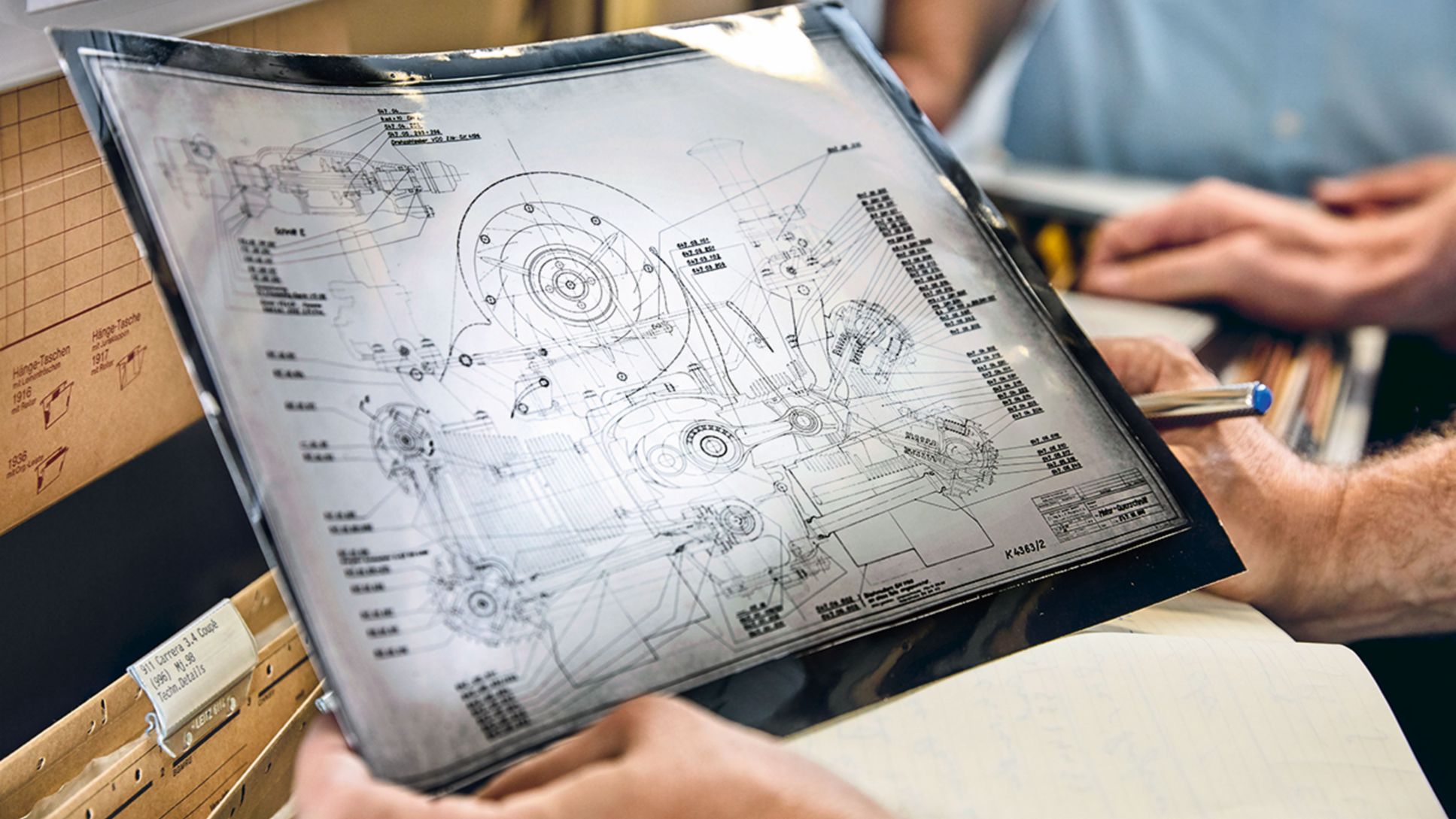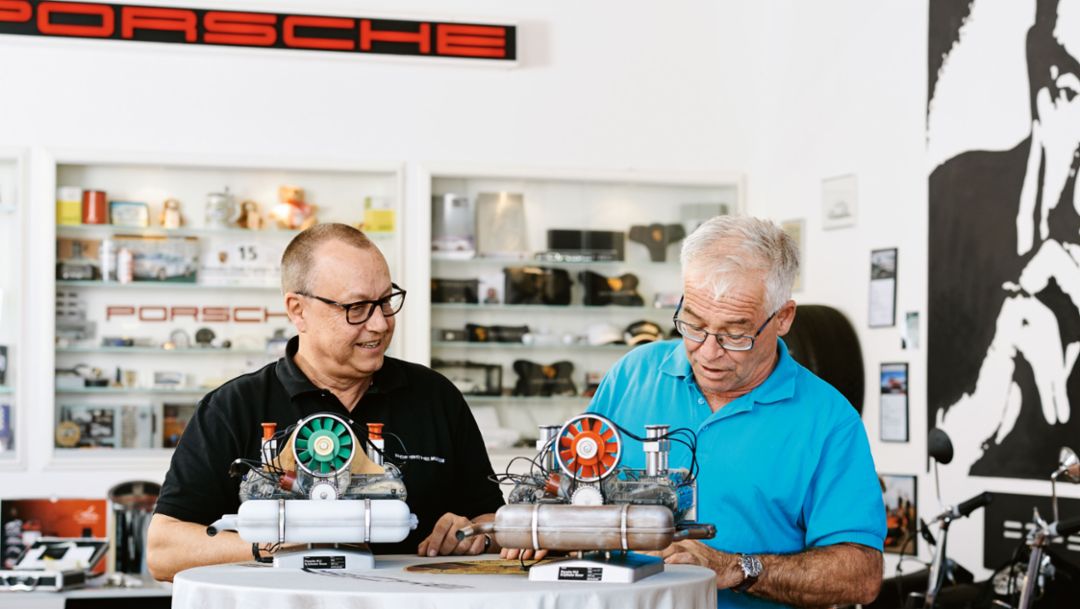The Porsche flat-six boxer engine model kit made by Franzis Verlag is a hot item in the Porsche Museum gift shop in Zuffenhausen, and no wonder. It’s a miniature masterpiece—a sentiment shared by fans. A concealed electric motor slowly sets the model in motion. Tiny light diodes flash red: 1 – 6 – 2 – 4 – 3 – 5. The ignition sequence is perfect; the sound comes from a small speaker under the 1:4-scale flat engine. The finished model was achieved with a grand total of 290 pieces, at least two hours of assembly time, and not a drop of glue on the fingers. Instead, the parts are fit and screwed together, as with the original, a six-cylinder Porsche 911 from 1966.
Porsche fans wouldn’t be Porsche fans if they didn’t approach this kit with exacting attention to detail. One of them turned it into a functional model that can generate up to 3,000 rpm. “Incredible,” says Frank Wessels, with an admiring whistle. The fifty-two-year-old model enthusiast from Havixbeck, near Münster, Germany, inspects his version of the 911 model. “It’s amazing that such engine speeds are possible! The engine has to have special bearings made of metal for that. Otherwise it would be tricky—just in terms of the play between the parts alone. You’d quickly have a piston-smasher on your hands.” He laughs and turns the engine, positioned on the workshop cart in front of him, to face him. Then he suddenly becomes thoughtful. A small lathe, a bit of brass—that’s all it would take to put some bearings on the crankshaft. Not a problem. His garage is well equipped and as tidy as can be. Wessels also tinkers with full-sized cars, of course, but his passion is reserved for model building. It took him only two hours to assemble the engine model. In the process, he noticed details that he wanted to refine further.
"As true to the original as possible—but also as practical as possible."
Details, mind you, that would have made some heads spin, had the Franzis Verlag publishing house included them. Cylinder heads, for example: “Our display engines always involve some small degree of compromise. They have to be durable and you have to be able to assemble them without glue,” explains John Anson, engine designer for Franzis Verlag and the “father” of the small flat-six engine. The cylinders, for instance, cannot be inserted individually; instead, they’re combined in a single piece per bank. The engine case is split horizontally rather than vertically to simplify the assembly. Why didn’t Porsche engine designer Hans Mezger think of that? Anson brushes off the suggestion with a smile. “No, no. The original has the best solution. But we model makers have to strike the right balance: as true to the original as possible—but also as practical as possible.” Wessels is understanding. As a matter of fact, he’s delighted. “That leaves more to do for crazy fanatics like me.” His engine, of course, has a metal tension band around the blower housing and the matching decal. With gasket paper, chrome foil, brass screws, and the painstaking application of spray paint, a miniature masterpiece took shape.
In the town of Nördlingen in Bavaria, local residents Thomas Müller and Joachim Nießlein also tinker with their model kits. “Take a look at that!” Thomas Müller—one of the organizers of the legendary ducktail meeting—taps the photo with his finger. “The exhaust pipe looks good this clean.” Joachim Nießlein nods. He’s reconstructed no fewer than five miniature engines. Walter Röhrl has one of them, a present for his seventieth birthday. “He was absolutely thrilled,” says Müller. For Nießlein, the “Röhrl engine” is his masterpiece. Except for the biplane that he built and flies himself. On a 1:1 scale, that is.
Nießlein’s passion is creating a patina, or the impression of aged construction parts. The process takes hours. With the exhaust, for example, Nießlein first coated it with a suitable paint and then rubbed it with oil paint and turpentine. The dark oil paint remained in the small grooves in the plastic. The simple molded part thus became a work of art—with the addition of tension bands made of super-thin sheet aluminum just 0.4 millimeters thick. “More of a foil,” says Nießlein. He’s always put a good deal of time into building the engine kits. After what has often turned out to be weeks of painstaking effort, the stunning results inspire covetous glances in the living rooms and workshops of his friends.
The ideas take shape in collaboration with Müller—one fine example being the exceptionally detailed carburetor on the “Röhrl engine.” Even the shielding plates are replicated—the unheralded shields meant to protect the carburetor against heat. For the next engine, Nießlein will attempt to replicate the carburetor actuator.
Further model in the autumn of 2018
This is not exactly what Martin Koschewa, responsible for marketing at Franzis Verlag, had in mind when he first contacted Jörg Thilow of the Porsche Museum. His original idea was to sell only functional models in the shop—engines without a specific model: “They were our first model kits. They were really only intended to illustrate how an engine works.” But after a quarter of an hour on the phone, Thilow said that Porsche would help Franzis Verlag create a replica of the first version of the iconic 911 engine, exactly as Hans Mezger had developed it. And they did, offering design drawings from the archive and visits to Porsche Classic—they pulled out all the stops.
The results are compelling. So it makes perfect sense that in the next phase of their collaboration Porsche and Franzis are set to bring a further model to market in the autumn of 2018. And it’s a doozy: the legendary Fuhrmann engine. A 1:3-scale prototype is already complete, including the vertical shaft camshaft drive.
The finely crafted air filters and very detailed carburetor surely make things somewhat trickier for the model builders. “Oh, do you really think so?” asks Thilow with a wink. He seems to have an inkling that fans like Frank Wessels and Joachim Nießlein will disappear into their hobby rooms on the first day of Christmas holidays 2018 and make their 1:3-scale Type 547 kits into very special miniature works of art.
Info
Text first published in the Porsche customer magazine Christophorus, No. 383

